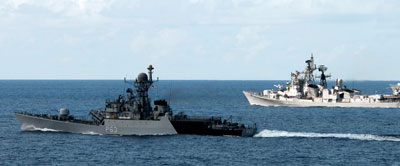INDIAN ARMED FORCES CHIEFS ON OUR RELENTLESS AND FOCUSED PUBLISHING EFFORTS

The insightful articles, inspiring narrations and analytical perspectives presented by the Editorial Team, establish an alluring connect with the reader. My compliments and best wishes to SP Guide Publications.

"Over the past 60 years, the growth of SP Guide Publications has mirrored the rising stature of Indian Navy. Its well-researched and informative magazines on Defence and Aerospace sector have served to shape an educated opinion of our military personnel, policy makers and the public alike. I wish SP's Publication team continued success, fair winds and following seas in all future endeavour!"

Since, its inception in 1964, SP Guide Publications has consistently demonstrated commitment to high-quality journalism in the aerospace and defence sectors, earning a well-deserved reputation as Asia's largest media house in this domain. I wish SP Guide Publications continued success in its pursuit of excellence.
- Indian Air Force Aims for Full Indigenous Inventory by 2047 — Air Chief Marshal A.P. Singh
- General Upendra Dwivedi takes over as the Chief of the Army Staff
- Rajnath Singh assumes charge as Defence Minister for the second consecutive term
- Admiral Dinesh K. Tripathi assumes Command of the Indian Navy as 26th Chief of the Naval Staff
- Prime Minister witnesses 'Bharat Shakti' – a Tri-Services Firing and Manoeuvre Exercise in Pokhran, Rajasthan
Indian Navy announces ambitious missile corvette requirement

As the Indian Navy formulates the specifications, the emphasis on stealth is significant since it will clearly be looking for stealth in design and construction as well, and not just in performance of systems, an indication of a robust continuation of the building ethic established in the P17 frigates and P15A destroyers.
Importantly, the Indian Navy has left displacement open, inviting this information from interested bidders. At this stage, the field is open with several PSU and private shipbuilders eligible and fully capable of participating in such a programme. The Indian Navy a year ago inducted its newest indigenous corvette, the 3,500 ton Kamorta-class, for specialised submarine detection and warfare. The NGMVs will add to the strength of the indigenous Khukri class and Kora class missile boats that form 'killer' squadrons.
The new ships fielded by competitors will have a complement of 11 officers, 02 trainee officers and about 80 sailors. In terms of range and speed performance, the navy has stipulated that the ship should sport a range of at least 2800 nm at sustained economical speed and 1000 nm at full throttle (35 knots, with max-sustained speed of at least 25 kn). The ship should be capable of operating at low speeds of 10 knots for atleast 8 hours continuously.
On the all-important propulsion system, the navy has stated that it should be able to provide the requisite power to weight ratio required for the ship. The propulsion system should also cater for greater endurance and operations in low speed regimes during Low Intensity Maritime Operations (LIMO) or Exclusive Economic Zone (EEZ) patrols. The main engines should be capable of achieving the rated speed at 85% MCR of the engine. The propulsion system should be suitably designed to meet the stealth requirements of the ship.
The weapons complex being sought by the navy provides a clear picture of the frontline surface-to-surface and surface-to-air capabilities that the navy is looking for in the NGMVs. For starters, the navy says the ship should carry a minimum of eight surface-to-surface missiles, a full-fledged SAM system with point defence capabilities currently possessed by the Barak-fitted surface combatants of the navy (the navy wants the NGMV's point defence to providing credible near 360-degree Anti Missile Defence (AMD) coverage to the ship, capable of engaging sea-skimming missiles, flying 3-5 m above sea level, upto a max speed of 3 Mach), an MR gun system, which encompasses a gun with stealth features sporting a range of at least 15 km and the capability to carry out surface to surface, surface to air and Anti Missile Defence (AMD) engagements. It should have the facility to be remoted using Fire Control Radars (FCR) as well as EO (Electro-Optical) sight, stipulates the navy. Indispensable on all new constructions for the navy, it wants close in weapon system (CIWS) that should be both radar and EO (Electro Optically) guided to double up as Low Intensity Maritime Operation (LIMO) weapon -- an indication of the ship's potential use in the anti-piracy and anti-infiltration role of the sort recently seen in the Arabian Sea. The navy stipulates that the placement of CIWS should be such that it provides near 360-degree Anti Missile Defence (AMD) protection without requirement of course alteration. The navy also wants a suitable chaff system to provide credible passive electronic counter measures capability against incoming missiles.
The sensors on the NGMVs will include an Infra Red Search and Track (IRST) system integrated with all gun mountings with the facility to interface with the Combat Management Sytem (CMS), the ship should be fitted with one each surface and air surveillance radar for early warning and Fire Control Radars (FCR) for target indication to all its weapons. The NGMVs will also sport a Combat Management System for network centric operations and quick response to situations at sea. The ship should also have a Ship Data Network (SDN), which should form the backbone to network all weapons, sensors, and other equipment.
As is now the norm, the navy will settle for nothing less than all the latest navigational aids on board, including Integrated Bridge System (IBS), ECDIS, AIS, LRIT, DGPS, COTS radar with good ARPA displays etc. Standard Naval IFF system would also obviously need to be part of the fit. The ship should have an Advanced Composite Communication Suite (ACCS) integrating all communication equipment to the communication data-bus. Once again stressing on the stealth factor, the navy has said that the number of aerials should be limited by using the concept of 'common aerial working' or similar concept.
Expanding on the crucial stealth requirement, the navy has stipulated, "The design of the ship should incorporate stealth features to minimise RCS and IR signatures. IR suppression features should be added onto the ship's exhaust system. Stealth fittings should be considered. The hull is to be made of DMR 249A steel and the superstructure is to be made of DMR 249A steel/ Aluminium. Shock mounts and low vibrations to ensure low acoustic noise should also be an integral part of the design."





